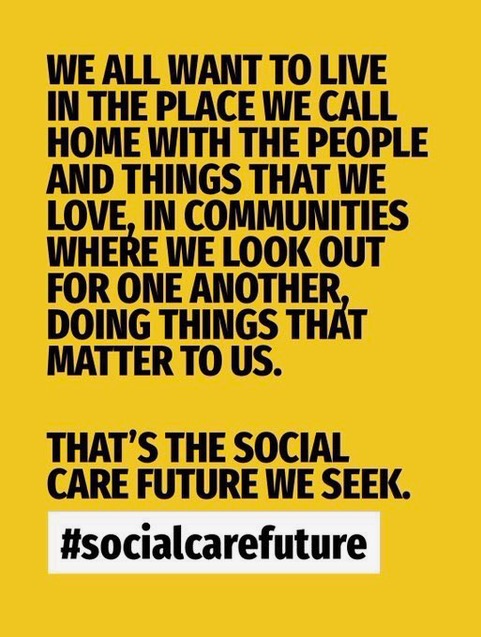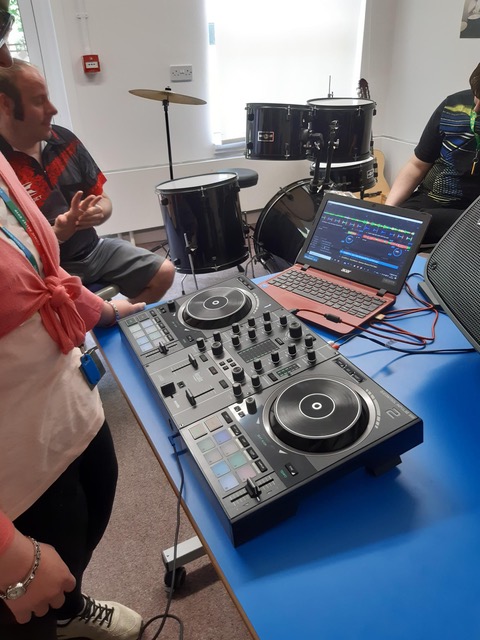Blog by Cath Barton – Community Circles Connector
As we continue to introduce Community Circles and promote the benefits, it’s made me think about how we do this well. Community circles, to me, is exciting, can lead to positive change, builds relationships, supports contributions and is a real privilege to be invited to be part of someone’s circle.
I’m conscious that I may be making an assumption that providers, staff and managers see Community Circles as positively as I do. I’m sure many people do but I don’t want to ignore the questions, assumptions, hopes and fears that staff may have about Community Circles.
I’ve been gathering information about some assumptions staff may make about Community Circles and have written responses to dispel any myths and support any fears that may be present:
“The people I support don’t need a Community Circle, they already have friends”
We all have different things in our lives that gives us quality but I often hear a common theme, that quality comes from the relationships in our lives. Thinking about a day I spent with Cormac Russell about Asset Based Community Development, we were asked to think about the connections and relationships that are present in the lives of the people we support. Often these relationships are family members or people who are paid to be in someone’s life. People often spend time with others with the same label but there may be an absence of natural relationships; connections and friendships that develop through shared interests, reciprocity or contributions.
When we think about the people we support having friends, are these relationships classed as friendships because people with the same label are spending time together, or are people’s friendships based on shared interests and a genuine desire to be in each other’s company? I think we need to honestly reflect on how well we support relationships to be developed and maintained. Community Circles are intentional about inviting people to be part of someone’s life. Circle’s can support new connections and relationships, support people to make decisions and positive changes in their lives. For some people circles occur naturally but for others, often people with a label or diagnosis, relationships aren’t as naturally occurring and we need to be intentional about inviting people to be part of someone’s life.
“It will be a lot of extra work for me to run the circle”
Community Circles are facilitated by a trained facilitator, someone who is able to contribute two hours a month, from any walk of life with a desire to support positive change. Facilitators are matched with the person wanting the circle based on availability, personality and common interests. Facilitators are given full training for their role, matched up with a buddy facilitator and have ongoing support from a mentor and connector. Within Circles we support everyone to have a role, such as hospitality, timekeeper and recorder. For example, Helen’s role as a circle member is hospitality as she loves to bake cakes. It is the circle, through conversations, learning and sharing that supports positive change in someone’s life. The paid member of staff may be invited to be part of the circle and may have a role in supporting the person to prepare for their circle meetings but are not expected to run the circle or have responsibility for all the actions which are developed.
“A Community Circle isn’t suitable because the person I support doesn’t use words to speak”
Amy doesn’t use words to speak but she does communicate, through her eyes, through her touch, through her body language and whether she invites you into her space. The purpose of Amy’s circle is to support her to have the life of her choosing. Because Amy doesn’t communicate verbally the circle needed to observe, share and capture information in order to make informed person-centred decisions. The circle identified early on that there were more questions than answers when it came to thinking about how Amy wanted to live her life. How did she want to be supported? What did she want to spend her time doing and who with? One action was to think about ways she could be supported to have new experiences.
This year Amy went to the Inclusive Communities Experience conference where she stayed with her dad in a shared cabin for two nights. Kevin has been going for years and he never imagined that it would be possible to take Amy who he knew would love it. With the help of Circle members, using their networks to liaise with Amy’s provider, they were able to agree enough support to make it happen. This has undoubtedly been an incredibly positive experience for Amy and her dad. They were able to enjoy a weekend away together, meet new people, make new connections and try new things.
The next Circle meeting will start with a celebration of the first positive outcome for Amy – recognising what can be achieved when people work collectively for a shared purpose. The approach that the circle took was not can Amy go away on his trip but ‘how’ can we support Amy to go away on this trip. The momentum that this carried was incredibly powerful and has given Amy’s Circle the confidence that together we can support Amy in her ambitions and Amy’s dad in the decision making process
‘I sit here, tears in my eyes. You don’t know how overwhelmed I feel, that my beautiful daughter has been accepted as a friend, and befriended on facebook, and in person by the people she has just met at the ICE conference. By people who accept her, and will talk to her even though she does not use words herself.
For the first time in 32 years I feel such emotion and joy, she is accepted as the beautiful woman she is, without conditions. Thank you.’
“Are Community Circles a way of getting rid of or reducing paid support?”
People with a need for additional support will always need an element of paid support in their lives but we recognise that however great the support is, quality and well-being in often comes from natural relationships in our lives, based on shared interests and reciprocity, knowing that we matter to others.
There is an economic case for Community Circles following research completed by London School of Economics. The research concluded the following;
- The avoidance of expensive residential care for the person with complex needs
- The mental health of family carers may be improved with reduced health service use
- Some carers feel they have been enabled to be employed /continue to be employed because of the support the Circle provides
- The employment of local people as personal assistants who can therefore input into the local economy
- Personalised care by individually selected staff who understand the person and who can respond appropriately, reducing the possibility of ‘challenging’ behaviour arising which might lead to the need for expensive specialist care
According to Martin Routledge, Head of Operations at In Control states; “At a time when services and communities are having to find ways of doing more with less, Circles seem to me to be the answer to so many of our challenges.”
For Mary, the purpose of her circle is to reconnect her with her faith community. At the moment Mary has paid support to go to church and to the church’s social club. However great that support is, we can appreciate the value we gain from having others around us who are not paid to be with us, but with whom we have relationships based on shared interests. Mary sometimes uses words to communicate but often writes her thoughts down, here she tells us how important church is to her “Friends as well again, I speak to people when I go to church”

The aim for Mary’s circle is to widen her connections and develop relationships and possibly in the future, go to church with other members of her parish, using her paid support for other things.
“There is nobody to invite to the circle”
A Community Circle can start with two people or several people coming together. Sometimes a circle can even begin with just the focus person and one other person, supported by the facilitator, making a commitment to work to build a circle of support around the person. Relationships can take time to make, to nurture and develop but is always worth the effort. When there is ‘nobody to invite’ we need to be all the more intentional about inviting people in. As Caroline Tomlinson says, services promote a ‘special system’ which tells the community that ‘specialist’ people are needed to support people who are labelled. We need to shift that assumption and invite people in.
“We won’t be able to keep commitment from the circle or maintain relationships”
We can’t predict the journey that the circle will take but what we are learning is that the benefits from a circle are far and wide reaching. Being part of a circle is an intimate gathering where people are invited into the heart of someone’s life. Circles make positive changes in ripples; not only for the person whose circle it is but also for circle members. The person whose circle it is, is supported to make positive changes in their life; the circle members bring their gifts and skills to contribute to making a difference and the facilitator supports the conversation and holds the circle together. Giving and connecting with others supports all our well-being.
“Being part of a circle is a very precious kind of privilege because it involves being welcomed into the heart of a family.
I get back far more than I give in return.”
Rev Alan Poolton circle member
“Is the circle being developed because staff haven’t done a great job?”
One of the benefits of a Community Circle is supporting good communication between people, bringing people together to think, share ideas and support decision making. Everyone has an opportunity to contribute and is involved in the decision making process. A Community Circle celebrates the good stuff that is being achieved and helps support the person to achieve the life they want. The Circle supports family, friends and paid staff to come together around a common purpose, have focused conversations that lead to action.
As Michelle Livesley says, “There may be an automatic assumption that the circle has been set up because the service isn’t working, therefore blame is attached and people might be less willing to engage positively. However, one circle I was involved in a few years ago quickly established just how good the person’s life was due to the great support he was getting”
Cath Barton
Community Circles Connector






